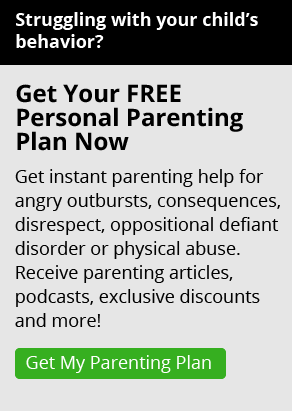I’ve worked with many parents who are frustrated because their child won’t accept ‘no’ for an answer. Too often, these parents feel it’s important to explain their reasoning in an attempt to get their child to understand. Unfortunately, wanting your child to understand can easily shift into wanting their approval or acceptance of your reasons.
When this happens, parents can get stuck in a dynamic where they’re over-explaining things to their children. I personally think that once you’ve given your child a reasonable amount of explanation, anything further defeats the purpose. And if you continue to try, you’re likely to give in just to end the arguing.
And when you give in, you’re training your child not to accept your rules. If you tell your child, “No, you can’t do that,” and they keep pestering, and you give in, they learn that pestering works. They learn they don’t have to accept ‘no’ for an answer. So you can see that many parents are teaching their children to challenge them without even realizing it.
How can you stop all the over-negotiating and over-explaining as a parent and get your child to accept ‘no’ for an answer? Try these seven practical tips that I would give parents in my counseling practice.
1. Skip the Shouting Match With Your Child
Some kids get angry when told no, and they manage that anger by demanding an explanation from their parents. They might say, “It’s not fair,” and start to act up. They take it out on you.
From there, things can often escalate into a shouting match. And if you’re shouting at your child (and, by the way, I understand how easily that can happen), then you’re now on the same level as far as they’re concerned. And when you’re down on their level, you negate your authority.
Certainly, the first time you yell, your child might respond the way you want them to. And it may work the second time, too. It may work the first ten times. But the day is going to come when the screaming doesn’t stop, and things escalate until they break something or punch a hole in the wall.
In my opinion, getting into a shouting match usually doesn’t work because your child just learns more aggressive ways to respond to you. And if a parent tells me their child won’t take ‘no’ for an answer, my response to them is always, “If you reward nagging, then your ‘no’ doesn’t really mean no. Instead, it means ‘keep nagging,’ ‘keep trying,’ or ‘maybe I’ll say yes if you pester me enough.’
If your child says, “You can’t make me!” and refuses to obey your rule, I recommend that you calmly say the following:
“I’m not here to make you. But there will be consequences if you break the rules.”
And then apply an effective consequence appropriate for the situation.
Related content: How to Give Kids Consequences That Work
2. Establish Your Authority Early On
If your kids are young, then establish your authority now. The earlier you firmly establish your authority, the easier it will be for your child to learn that ‘no’ means no.
Parents establish their authority by setting limits and having a structure. For example, you don’t let your two-year-old walk by the street. And you don’t let your three-year-old go out by the pool. You set limits and enforce them. Limits establish the structure you will use as a parent for the rest of their childhood. So start early and be consistent.
If your kids are already older, don’t be discouraged, but know that it’s going to take some more time and persistence to re-establish that ‘no’ really means no.
3. Learn How to Handle Young Kids Who Get Overstimulated
Remember that sometimes young kids get overstimulated, and when that happens, it’s difficult for them to respond to direction. And so parents have to keep that in mind.
If kids are overstimulated and get carried away, take them to their room where they can sit and take a break for five minutes. That will allow them to calm down. Then you can talk with them simply and firmly about their boundaries.
Ask them if they’re ready to follow the rules, and if they agree, allow them to go. But if they continue to resist, have them stay put until they’re ready. If your child gets overstimulated in a store, you can use your car as the calm down area.
4. Turn Around and Walk Away if Your Child Keeps Nagging
I believe the best thing you can do when your child won’t stop arguing with your rules or consequence is to say in a business-like manner:
“I’m not going to discuss this any further.”
Then turn around and walk away. Don’t respond to any backtalk. So if you say ‘no’ and your child starts saying, “But, but, but…” just keep walking. If you give them the power to turn you back around, they’ll turn you back around again and again.
I think kids need a reasonable amount of explanation, but after you’ve done that, you don’t owe them anything more. It’s not productive.
5. Explain the Rules to Your Child When Things are Calm
The time to explain concepts to your child is when things are going smoothly. So when things are calm, sit down and say to your child:
“When I tell you ‘no,’ I don’t want to talk to you anymore about that. ‘No’ means no.”
You can help coach them if the word ‘no’ is particularly frustrating to your child. Say:
“If you don’t like ‘no,’ if that makes you frustrated, go to your room and draw for five minutes. Go do something to calm yourself down.”
That should start very early. And let me be clear: if you give in to temper tantrums from kids who are two and three and four years old, you’re training them to challenge your authority. You’re teaching them that you give in when they act out. And they’ll use the same tactics whenever you challenge them.
And keep in mind that if it works in childhood and is not corrected, they’ll use it as adults, which will lead to even more problems.
6. Being Overly Strict Can Backfire
Being overly strict can backfire in the long run. As a parent, you want to give your kids more freedom as they get older and demonstrate that they’ve earned your trust. But do so on your terms so that you maintain your parental authority.
I believe part of the job for parents is to teach their kids how to accept limits. But I also think parents need to allow their children to challenge and test limits appropriately. It’s natural for kids to test limits—it’s how they grow. Parents often ask me, “Will this ever stop?” And I say, “It shouldn’t. But what should stop is any manipulation or intimidation that your child is using.”
7. Don’t Try To Be Your Child’s Friend
Your job as a parent is to teach your child, coach your child, and set limits. The limit setting role, in particular, is an essential part of your parenting style. Parents will often tell me they don’t like to set limits. These are the same parents who tell me they want to be friends with their kids. I understand that, and I’m not judging them.
But I think it’s a misconception that the parent-child relationship is about friendship, especially in the early years. My son didn’t need me as a friend. He needed me as a parent to say:
“No, you can’t stay out after ten o’clock on Friday night unless I know where you’re going to be.”
Or,
“It’s time to turn off the electronics and start your homework.”
Personally, I think the parent-child relationship is lifelong and complex. If your child is going to be friends with you, that probably won’t happen until they’re adults. And that’s okay.
Related content: Your Child Is Not Your Friend
By the way, even though I don’t advocate being your child’s friend, I think you should be friendly with your kids. That’s the positive regard I often mention. Talk to your kids as if you like them, even when saying ‘no.’ Don’t scowl. Be warm and speak with a soft tone that gives them the message that you care about them.
I know this can be hard, especially when you’re frustrated, and your child has been acting like a pill. Still, it’s important to be as positive as you can when dealing with them because they pick up on any negative feelings very quickly and soon internalize them—or rebel against them aggressively.
Conclusion
Parents have to be clear and honest with themselves about the reality of the situation if they have nurtured this “never take no for an answer” problem in their kids. If your child is pushing back when you say ‘no,’ understand that up until now, you’ve watered and fed that behavior, and it grew. So to expect this behavior to change without any conflict is unrealistic.
I believe you need to set limits and stick to them while remembering that your child will not turn around their behavior in one day. If you’re only starting when he’s fifteen, remember that you’ve shown your child that you’re a pushover and that you don’t mean what you say. Once you inadvertently train your kids to believe that, it takes time to break that training.
These are hard patterns to turn around, but parents can do it. You have to come up with a game plan. That game plan should include what you’re going to do, how you want your child to act in any given situation, how to teach them to do it, how to respond to them if they get so overwhelmed they can’t do it, and how to set limits on behavior. In my opinion, these are the basics of sound parenting, and it’s a big part of what I teach in my Total Transformation® child behavior program.
The good news is that with effective parenting tools, unless your child has some severe behavioral disorder, eventually most kids will turn around and start responding—that’s all there is to it.
Related Content:
In Over Your Head? How to Improve Your Child’s Behavior and Regain Control as a Parent
Are You Afraid of Your Acting-Out Child? Part I: Why Giving in is a Dead End
About James Lehman, MSW
James Lehman, who dedicated his life to behaviorally troubled youth, created The Total Transformation®, The Complete Guide to Consequences™, Getting Through To Your Child™, and Two Parents One Plan™, from a place of professional and personal experience. Having had severe behavioral problems himself as a child, he was inspired to focus on behavioral management professionally. Together with his wife, Janet Lehman, he developed an approach to managing children and teens that challenges them to solve their own problems without hiding behind disrespectful, obnoxious or abusive behavior. Empowering Parents now brings this insightful and impactful program directly to homes around the globe.
You must log in to leave a comment. Don't have an account? Create one for free!




After working as a child psychologist for over 40 years I have learned that some children do not understand punishment. They think we as parents are being mean. It helps a lot to say to a tantrumming child after they calm: what made you so upset. And then explaining: You asked me for something I cannot get you. Ask me what you have to do to get what you want? Then if they are asking for a real helicopter- let them know when they are adults and make a lot of money then you can buy one.
Also, if they know what 5, 4, 3, 2, 1 means, get them an inexpensive smart watch with a heart rate feature. Have them wear the watch. Model deep breathing and say: Look, you are making the numbers go down!